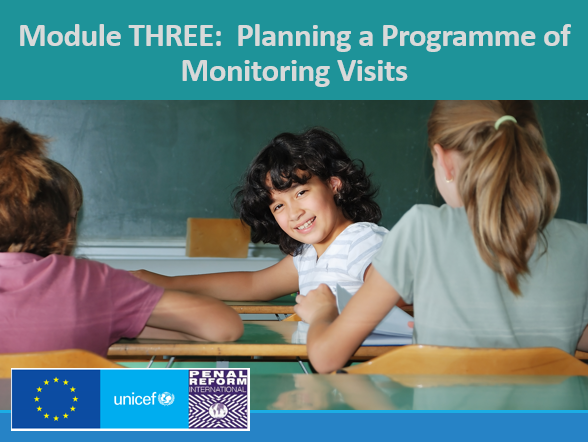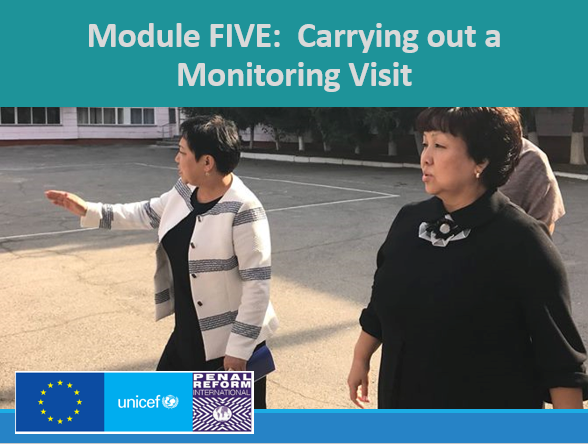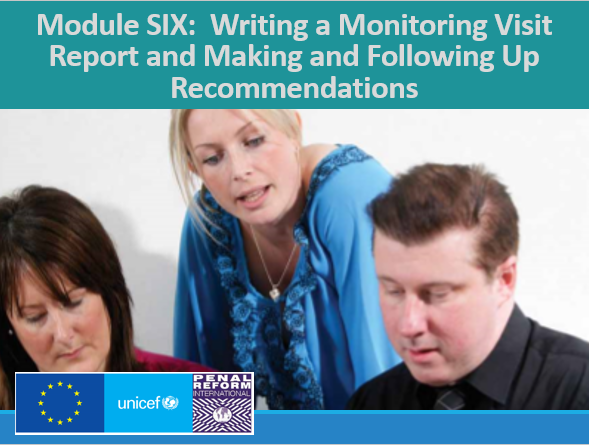Monitoring Places where Children are Deprived of their Liberty
by Professor Pauline McCabe OBE
International Criminal Justice Advisor and former Prisoner Ombudsman for Northern Ireland
International Criminal Justice Advisor and former Prisoner Ombudsman for Northern Ireland
|
Monitoring Toolkit Handbooks and Resources
|
Module ONE- Introduction to Monitoring and International Law
Introduction
Welcome to Module One!
Module One provides some important background information to set the scene for this on-line training course. The purpose of this module is to set the scene for the training that follows. The module is not assessed.
The module has two lessons:
Lesson 1.1: An introduction to Monitoring places where children are deprived of their liberty
Lesson 1.2: Children Deprived of their Liberty - International Legal Framework
Modules Two to Six contain a series of PowerPoint presentations, exercises, checklists and Handbook reading tasks. Because Module One has been prepared as background information, learners are simply required to read this Lesson Plan; look at two presentations and complete one reflective exercise. Lesson Two does, however, contain links to International Human Rights Instruments which learners are encouraged to scan or read. Learners can choose to return to Module One at any time, if they wish to study the Human Rights Instruments in more detail.
The time taken to complete this module will depend upon the time that learners wish to spend examining the Human Rights Instruments described in Lesson Two.
Module One provides some important background information to set the scene for this on-line training course. The purpose of this module is to set the scene for the training that follows. The module is not assessed.
The module has two lessons:
Lesson 1.1: An introduction to Monitoring places where children are deprived of their liberty
Lesson 1.2: Children Deprived of their Liberty - International Legal Framework
Modules Two to Six contain a series of PowerPoint presentations, exercises, checklists and Handbook reading tasks. Because Module One has been prepared as background information, learners are simply required to read this Lesson Plan; look at two presentations and complete one reflective exercise. Lesson Two does, however, contain links to International Human Rights Instruments which learners are encouraged to scan or read. Learners can choose to return to Module One at any time, if they wish to study the Human Rights Instruments in more detail.
The time taken to complete this module will depend upon the time that learners wish to spend examining the Human Rights Instruments described in Lesson Two.
Lesson 1.1: Depriving Children of their Liberty
Children deprived of their liberty are particularly vulnerable because of their age, level of maturity and psychological fragility.
Depriving children of their liberty must be exceptional and should be used only as a last resort and for the shortest possible period of time. The aim should always be to educate, rehabilitate and prepare children for reintegration into society and the use of alternatives to detention should always be given priority.
Lesson 2.1 is an introduction to monitoring places where children are deprived of their liberty and explains the role of monitoring in protecting and promoting the rights of vulnerable children.
Please begin by clicking on the Presentation Icon to look at PowerPoint 1.1.
Depriving children of their liberty must be exceptional and should be used only as a last resort and for the shortest possible period of time. The aim should always be to educate, rehabilitate and prepare children for reintegration into society and the use of alternatives to detention should always be given priority.
Lesson 2.1 is an introduction to monitoring places where children are deprived of their liberty and explains the role of monitoring in protecting and promoting the rights of vulnerable children.
Please begin by clicking on the Presentation Icon to look at PowerPoint 1.1.
Lesson 1.2: On-line Training Course and International Standards
It is not necessary for every monitor to be an expert in human rights law because the monitoring standards and checks described in this training course have been fully informed by the international legal and normative standards.
But it is helpful for monitors to know the overall purpose of each of the sources of the international legal and normative standards, so that they can research or refer to them if and when needed.
The slides that follow briefly describe the international standards and include links to further information.
Please begin by clicking on the Presentation Icon to look at PowerPoint 1.2.
But it is helpful for monitors to know the overall purpose of each of the sources of the international legal and normative standards, so that they can research or refer to them if and when needed.
The slides that follow briefly describe the international standards and include links to further information.
Please begin by clicking on the Presentation Icon to look at PowerPoint 1.2.
Now that you have the considered the role of monitoring in protecting and promoting the rights of vulnerable children deprived of their liberty and looked at the relevant international Standards, please complete Exercise 1.2.
Exercise 1.2 is a reflective exercise for your own use. Please click and save your completed answers. You may wish to look back at your answers as you work your way through the on-line training modules.
If at the end of the On-line training you have any outstanding concerns, please discuss these with an experienced monitor or other professional with experience of oversight and accountability. Ask for any help you need to address your concerns and develop your expertise and confidence.
Remember that this on-line course is intended to supplement, not replace, classroom or one to one practical training. It is always good to seek help, coaching or mentoring where this is needed.
Please click on the Exercise Icon 1.2 to begin.
Reflective Exercise 1.2
What's Next?
ou are now ready to begin the On-line Training Course. Module Two looks at the Monitoring Toolkit Standards and Checks, including gender specific standards. It considers also how monitors should gather evidence to assess the performance of the visited facility. against the standards.
Begin that module when you are ready.
Begin that module when you are ready.













